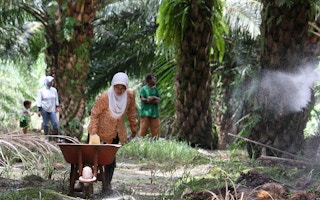Palm oil giant Korindo Group is alleged to have set fires to clear rainforest in Indonesia’s easternmost region of Papua, a practice that is banned by law.
The allegation was raised by Greenpeace International and Forensic Architecture, a research group based at the University of London, whose joint investigation found indications of deliberate burning by the Indonesian-South Korean joint venture.
To determine the origin and nature of the fires in a concession held by Korindo subsidiary PT Dongin Prabhawa in Papua’s Merauke district, Forensic Architecture looked at NASA satellite imagery from October 2011 to January 2016. It also analysed video from aerial surveys conducted by Greenpeace International campaigners in 2013 to determine what’s known as the normalised burn ratio, essentially identifying burned areas and estimating fire severity.
Forensic Architecture noted that the pattern of fires — their direction and the speed with which they moved — matched the pattern of land clearing in the periods of February to May 2012, July to December 2012, February 2013, April to December 2013, January 2014, April to December 2014, and May to December 2015.
This, said Forensic Architecture senior researcher Samaneh Moafy, is an indication of deliberate burning.
“If the fires in Korindo’s concession were natural, the outbreaks would be irregular,” she said. “However, tracking the movements of deforestation and fires over time shows that they clearly happen in sequence with fires following the clearance in a west to east direction and overwhelmingly happening inside Korindo’s concession boundary.”
A comparison with a nearby plantation held by another company, PT Internusa Jaya Sejahtera, showed that the fires and land clearings on PT Dongin Prabhawa’s land are more frequent and exhibited a stronger sense of direction, further supporting the allegation that the fires were set intentionally in the region.
“
If the fires in Korindo’s concession were natural, the outbreaks would be irregular. However, tracking the movements of deforestation and fires over time shows that they clearly happen in sequence…
Samaneh Moafy, senior researcher, Forensic Architecture
This is not the first allegation of arson by Korindo. In 2016, a coalition of NGOs, including the campaign group Mighty Earth, published a report on Korindo that identified at least 30,000 hectares (74,000 acres) of deforestation and more than 900 fire hotspots on Korindo’s oil palm plantations in Papua and North Maluku province since 2013.
Since 2001, Korindo had allegedly cleared a total of 57,000 hectares (141,000 acres) of rainforest in Papua province alone, an area about the size of Chicago, according to Papua Atlas. Papua Atlas is a real-time interactive map showing the spread of plantations and roads in the Papua region, developed by the Center for International Forestry Research (CIFOR).
According to another recent report by Greenpeace, 11,300 hectares (28,000 acres) of Korindo’s concessions burned from 2015 to 2019.
In 2017, Mighty Earth filed a complaint against Korindo, which controls the largest swath of oil palm plantations in Papua, to the Forest Stewardship Council, considered the world’s foremost body certifying the sustainable forestry industry.
After two-year investigation, the FSC, which has certified some of Korindo’s forestry operations, concluded in a heavily redacted report that there’s “evidence beyond reasonable doubt” that there had been large-scale clearing of natural forests in Korindo’s concessions.
However, the FSC said it didn’t find strong enough evidence of deliberate burning.
“Although satellite images show the presence of smoke from fires on Korindo concession areas, it could not be determined that fires were set with the intention to clear land,” the FSC said.
On its website, Korindo said it “has never used and will never use fire to clear land in any of its operations.”
And in a response to the latest allegation, Korindo told the BBC that the fires in its concessions were either natural fires caused by extreme dryness or started by “villagers hunting giant wild rats hiding under stacks of wood.”
But villagers who live around the PT Dongin Prabhawa plantation say they saw Korindo employees setting fires on the company’s land over a period of years that matched the findings of the visual investigation.
Sefnat Mahuze, a local farmer, said he saw Korindo employees collecting leftover wood and stacking them into large piles.
“And then they poured petrol over it and then lit them,” he said as quoted by the BBC.
Greenpeace Southeast Asia forest campaign head Kiki Taufik said Korindo’s explanation of the fires on its concessions was merely an excuse.
“From [the visual investigation] and the villagers’ testimonies, it’s very clear that [the fires] were started by the company,” he told Mongabay.
In light of the findings, Kiki urged the Indonesian government to hold Korindo and other plantation companies accountable for the fires on their land and for the resulting damage to people’s health and the environment.
“Instead, the government’s track record shows inconsistent and weak law enforcement, combined with a weakening of environmental safeguards under the recently passed pro-business omnibus law,” he said.
This story was published with permission from Mongabay.com.










